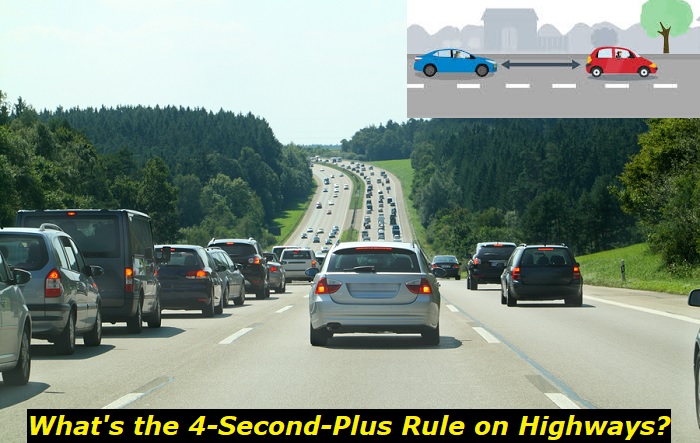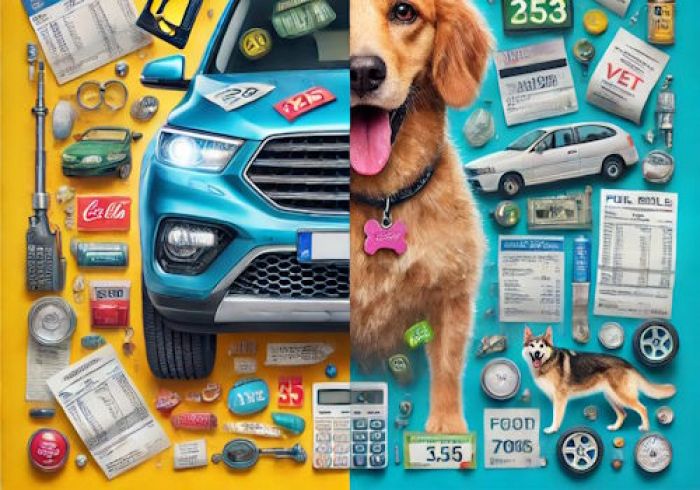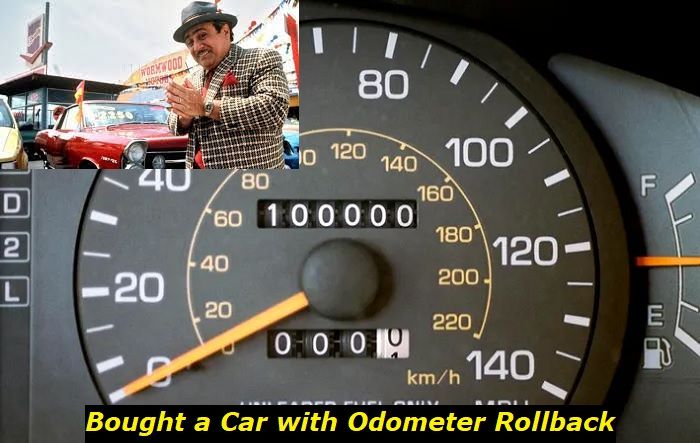The safety of your driving is always the most important factor. But how can you drive safely? For this, you should know some unwritten rules that no one will teach you in the driving course. They say you should keep a certain distance from a car that drives in front of you and even say it in feet. But can you immediately count feet to the moving object? I can't.
So, there is a rule of 4 seconds plus that tells you about the perfect distance to the vehicles on the highway.
In short, the 4-Second-Plus rule tells you that you should go at least 4 seconds away from another vehicle on the highway, so you should get to the point that the car just passed in no less than 4 seconds.

Although this may seem too tangled and complicated, it's much more practical than trying to guess how many feet there are between you and the car in front of you. So, let's look at this rule in some more detail.
What's the best distance between cars on the highway?
Although keeping a certain distance between vehicles is important at all times, doing this on highways is life-saving. When your car goes quite fast, it's very hard to react when something goes wrong on the road. If the car in front of you suddenly brakes sharply, you may just rear-end it and get into a bad road accident with a lot of risks for you and your passengers.
So, the traffic rules don't give a certain answer to the question about the distance between two vehicles on the same highway lane. They say it should be safe.
Specialists and professional drivers say that the safe distance is about 1 meter for each mile per hour of speed. So, if you go 60 MPH, the safe minimum distance between your car and the vehicle in front of you should be about 60 meters. OK, but how do you count those meters?
Unfortunately, if you try to measure distance with the naked eye, you will end up having absolutely different from the real measurements. Our eyes can't measure distances correctly, especially when two objects are simultaneously moving at high speed.
So, the solution to this problem is the 4-Second-Plus rule that is widely used by experienced drivers. Let's see what it means.
What's the 4-Second-Plus rule?
This is the unwritten rule that is highly recommended by drivers all around the world. It means that the distance between your vehicle and the other car that drives in front of you on the highway should be about 4 seconds.
If you just count it up, you will see that at the speed of 70 MPH, you can go about 100 meters in 4 seconds and this is the optimal distance at this speed. But if you are driving 35 MPH, you will cover about 50 meters for 4 seconds and this will be the safest distance for this speed.
Actually, the rule of 4 plus seconds should only be used on highways. In the city traffic, the distance of the same time frame will be too large, in my opinion. But for highways, this is the safest way to drive. The larger distance you keep, the easier it is to react to any unpredictable situations on the road.
When should you use the 4-Second-Plus rule?
Well, I'm pretty sure that the rule will be very useful for all drivers, regardless of their experience. I've witnessed so many cases when cars were just sticking to other vehicles on highways whereas there was so much space to keep the proper distance. And this is not the mistake that only newbies make.
The best speed range for this 4-Second rule is between 50 MPH and 100 MPH. Faster than that, the safe distance should be about 300 feet or more and this is not too practical in the US because there are almost no roads you can drive that fast. So, between 50 MPH and 100 MPH, you can use the 4-Second-Plus rule and be much safer on the road.
How to count these 4 seconds of distance?
If you want to develop the habit of driving at a safe distance from other cars on the highway, you should use this 4-Second-Plus rule. Some drivers say that 3 seconds are quite enough for safe driving, but I believe, in this case, the more, the better. Especially, if you are only starting to drive.
So, here's how you can understand you are at a safe distance:
- get on the highway and keep a certain safe distance from a car that is in front of you;
- find a certain object like an electric post or some road sign that the car in front of you is going to pass now;
- once that car passes the object, start counting from one to four;
- approximately when you count to four, you should pass the same object on the road;
- if you counted only to 2 or 3, slow down a bit and let the car in front of you go further from your vehicle;
- if you count to 5 or 6, then you may want to speed up a bit and make the distance shorter (but it's not necessary);
- repeat the experiment with counting when you adjust your distance and see if now it's OK.
This is probably the easiest way to understand that you are driving at a safe distance. You should use this rule whenever you are on the highway. After about 5 or 6 times you do this, your brain will remember that a certain distance is safe for you. Later, you will not need to count all the time - the eye will measure the distance easily. Maybe, you will want to sometimes check if everything is OK by counting to four again.
Why is a four-second distance safe for everyone?
All people have different speeds of reaction. Also, some cars are more responsive to the steering wheel and brakes than others. So, the average and common rule of three-second distance is not always appropriate. I don't understand why you should keep a 3-second distance if you can go more than that. Take 5 or 6 seconds if you still feel in danger with the disrobed 4 seconds.
But the experience of many drivers shows that the 4-Second-Plus rule is probably the most all-purpose and the safest rule you can come up with when it comes to distance on the road.
Here's why:
- you get more than enough space for maneuvering if something goes wrong;
- when a person sees danger on the road, it takes about 1.5 seconds to react, so you will have some extra time to brake or turn;
- in some conditions, like tiredness or sleepiness, your body will take more time to react in dangerous situations;
- people are not always watching the road, you may look at the infotainment display for a fraction of a second and lose precious time;
- there is no rule of too large distance on the road, but if it's too small, you may be even found guilty after a road accident;
- most cars in good trims will have collision-preventing sensors that will be most efficient if you follow the safe distance rules.
You may see now that keeping a safe distance on highways is extremely important. This will help you avoid collisions and other unpleasant situations on the road. Remember that the road is the place where everything may happen and you better be ready for all of these challenges by just keeping a safe distance. This is the easiest way to save your life and health.
How else can you keep a safe distance in a modern car?
The majority of modern vehicles that are in a good trim have anti-collision systems and sensors that can prevent road accidents by automatically braking or even turning when needed. The set of collision-preventing sensors in the front part of the vehicle can also be used for the so-called adaptive cruise control.
If your vehicle is equipped with such a thing, you can just set up the needed distance from the vehicle that goes in front of you. For example, this can be a distance of 150 feet and the vehicle will at all times keep this distance.
Also, the system may keep your car in the lane by watching the lane marks on the road and keeping a certain speed using the standard feature of cruise control. You basically get an autopilot. But it will still need your full attention and will eventually turn off if you don't pay attention and don't hold the steering wheel with your hands.
Using these modern features is a really good idea but you should never rely on them completely. Always control the way your car moves on the road.
Final thoughts
You may have heard about different rules to measure the safe distance on highways. Today, I have explained all of them in this article. I hope, now you don't have any questions and may easily set up the best distance on the road and drive safely.
Remember that it's always better to keep a larger distance between cars on the highway. The bigger the distance, the safer the ride.
About the authors
The CarAraC research team is composed of seasoned auto mechanics and automotive industry professionals, including individuals with advanced degrees and certifications in their field. Our team members boast prestigious credentials, reflecting their extensive knowledge and skills. These qualifications include: IMI: Institute of the Motor Industry, ASE-Certified Master Automobile Technicians; Coventry University, Graduate of MA in Automotive Journalism; Politecnico di Torino, Italy, MS Automotive Engineering; Ss. Cyril and Methodius University in Skopje, Mechanical University in Skopje; TOC Automotive College; DHA Suffa University, Department of Mechanical Engineering






Add comment